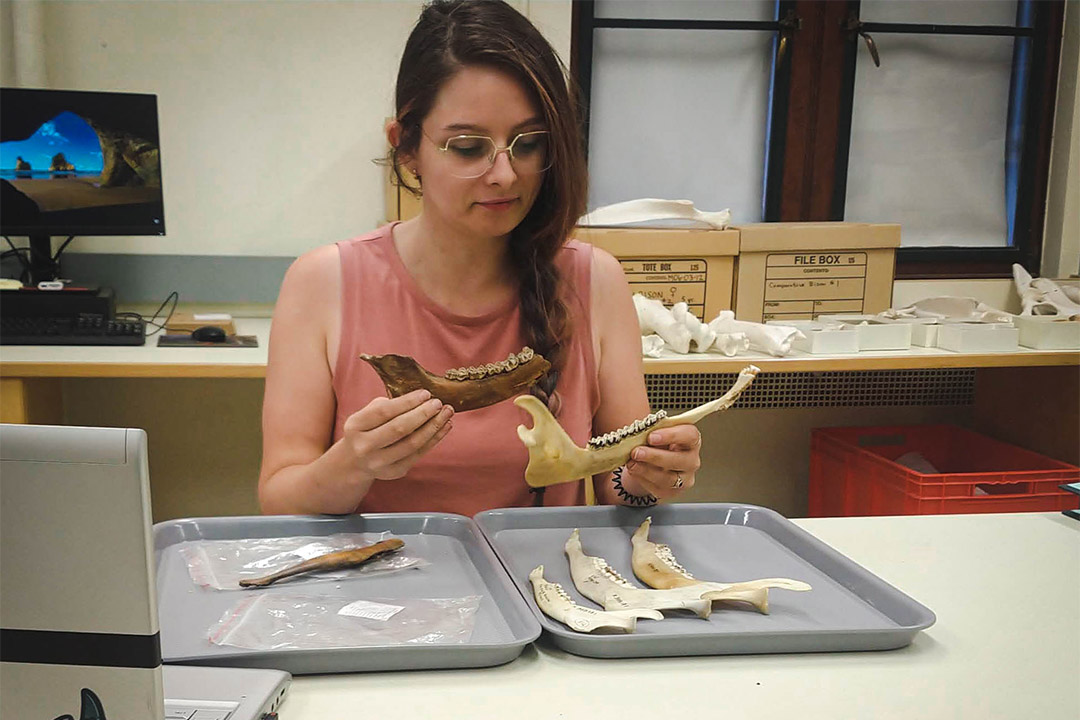
USask researcher investigates human-reindeer relationships by examining animals’ teeth
Examining how animal teeth wear over time may shed new light on the relationships and interactions between humans and animals throughout history, says University of Saskatchewan (USask) graduate student Grace Kohut.
By BROOKE KLEIBOERKohut is part of a research team examining how Nenets–Indigenous people from the Iamal Peninsula of Arctic Siberia–interacted with reindeer, and how the animals were used to help the humans survive.
“To Nenets, everything is interesting about reindeer, as this animal is a crucial species for their well-being, playing a critical role in their diets, annual migrations and clothing,” said Kohut, a graduate student in the Department of Archaeology and Anthropology in USask’s College of Arts and Science.
Reindeer were used by the Nenets people for everything from transportation to food and clothing resources. The Iamal-Nenets region continues to be an active area for reindeer herding to this day.
To determine how reindeer contributed to the lives of the Nenets people, Kohut and her research supervisor, USask assistant professor Dr. Tatiana Nomokonova (PhD), are analyzing the wear on samples of reindeer teeth from the region.
“Tooth wear can be a relatively fast, inexpensive, and most importantly, non-destructive method of assessing reindeer ages,” said Kohut. “My tooth-wear age-estimation method will be used for the first time to identify Indigenous animal age categories in the past.”
Kohut said teeth can tell many stories that are helpful in determining how reindeer co-existed with humans in an environment.
“Studying tooth wear and eruption works well for identifying some individuals that fall within certain Nenets reindeer age categories, especially the younger animals critical for making clothing and older animals whose hides can be used for bedding and dwelling covers,” said Kohut.
Similarly, if plants or lichen closer to the ground were eaten due to reduced vegetation, the animals’ teeth will wear down faster. If advanced tooth wear is seen compared to age, then the reindeer likely experienced poor grazing and forage conditions frequently.
This type of information about the past can be useful to the Nenets people in the future as they continue to rely on reindeer herds for many aspects of survival. Kohut hopes to develop a series of public outreach activities co-designed with the Nenets people to share the information with their youth.
“While studying and working in archaeology I’ve found the diversity of ways that people interact with, use, and relate to animals really interesting. My research is a part of a larger collaborative project designed to interconnect past and present uses of reindeer, including the incorporation of Nenets’ knowledge directly into archaeological research,” she said.
In addition to supporting the Nenets people in efficient and informed reindeer herding, Kohut also plans to change the way researchers use tooth wear to estimate age.
“Many of the existing tooth-wear methods I reviewed were developed by wildlife researchers,” said Kohut. “My plan is to also make a user-friendly open-access field manual for anyone who is interested in using it.”
She said this work could help Indigenous people in Canada delve further into the lives of animals that are important to their way of life.
“These animals (like reindeer and caribou) remain important to many Indigenous peoples across the Circumpolar North, including in the Canadian North,” she said. “Application of my methods could increase understanding about caribou use at such sites and provide further information on how caribou are impacted by management and hunting policies today.”
The project has been supported by the Social Sciences and Humanities Research Council of Canada, and the USask Department of Archaeology and Anthropology.
This article first ran as part of the 2022 Young Innovators series, an initiative of the USask Research Profile and Impact office in partnership with the Saskatoon StarPhoenix.

